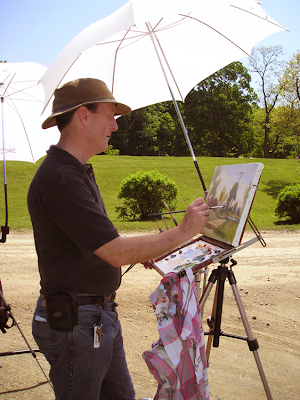Another way to cope is to always face your line of sight toward the sun, so the painting itself is in the shade, and it casts a shadow over the palette. But you can’t always limit yourself to looking in one direction. Sometimes you want the sun at your back.
 The solution is the white umbrella, which helps to soften the sun's glare into an even, indirect light. Even if you are painting in a deep forest, little shafts of light will travel across your painting, and the umbrella will eliminate their distracting patterns.
The solution is the white umbrella, which helps to soften the sun's glare into an even, indirect light. Even if you are painting in a deep forest, little shafts of light will travel across your painting, and the umbrella will eliminate their distracting patterns.To support the umbrella I use a “C-stand,” or Century Stand. A photographer told me about this vital piece of support equipment, standard stuff in the movie industry, but most artists don’t know about them. They’ll hold anything at any angle.

The goal for illuminating your work on location is to make the light level on the painting equal to the illumination in the scene itself. That way you can judge colors much more accurately.
This photo was taken of a painting directly in front of the landscape. It is lit by the light of a white umbrella, so the levels are pretty close.

By the way, some umbrellas are opaque, with black or gray on the inside. This doesn’t help, because you need the light from above, diffused through the umbrella, not bouncing up from the ground. Get one that is a translucent white nylon.
But with umbrellas, beware of the wind. I’ll talk about that hazard, frequently my downfall, in a future post called "The Disaster at Kaaterskill Creek."
Không có nhận xét nào:
Đăng nhận xét